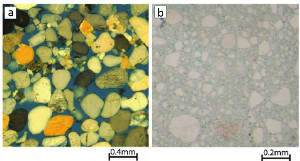| |||||||
|
|
|||||||
|
|
|||||||
| Fault Rock | |||||||
|
Fault rock refers to the comminuted rock at the core of a fault, resulted from the frictional sliding across the fault. Depending on the magnitude of strain across the fault, the proportion of the fine grained component of the fault rock may increase (Figure 1). The width and grain size distribution of a fault rock are geometric and mechanical parameters of a fault zone with important implications for fault strength and fluid flow across faulted regions. In some cases fault rocks are included within fault zones. In some other cases, attempts have been made to separate them from surrounding components, particularly the damage zone, of fault zones. It has been established that both fault zones and fault rocks associated with mature fault zones are highly heterogeneous and complex (Flodin et al. (2005). It has also been suggested that the width of fault zones are highly variable questioning some proposed relationships between slip-width relationships in the early literature (Evans, 1986; De Joussineau and Aydin, 2007). Never-the-less some numerical representation of these parameters are useful (see the section 'Scaling between Fault Rock Width and Fault Slip'). | |||||||
| Types of Fault Rock: | |||||||
| Fault BrecciasSmeared Shale | |||||||
| Reference: |
|||||||
| Ahmadov, R., 2006 de Joussineau, G., Aydin, A., 2007 Evans, J.P., 1990 Flodin, E.A., Gerdes, M., Aydin, A., Wiggins, W.D., 2005 |
|||||||
|
Readme | About Us | Acknowledgement | How to Cite | Terms of Use | Ⓒ Rock Fracture Knowledgebase |
|||||||
